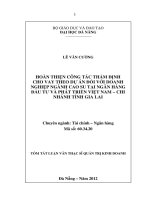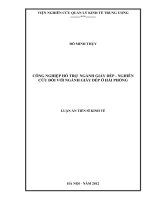Ngành giấy Ấn Độ
Bạn đang xem bản rút gọn của tài liệu. Xem và tải ngay bản đầy đủ của tài liệu tại đây (756.25 KB, 17 trang )
<span class="text_page_counter">Trang 1</span><div class="page_container" data-page="1">
India’s share in global paper demand is gradually growing as domestic demand is increasing at a steady pace while demand in the western nations is contracting The domestic demand in India grew from 9.3 million tonnes in FY08 to 15.3 million tonnes in FY16 at a CAGR of 6.4%. In spite of the sustained growth witnessed by the industry, the per capita paper consumption in India stands at a little over 13 kg which is well below the global average of 57 kg and significantly below 200 kg in North America. As per IPMA’s (Indian Paper Mills Association) estimates, this industry contributes approximately Rs 4,500 crore to the exchequer and provides employment to over 5 lakh people across approximately 750 paper mills. The broad characteristics of the industry are that it is capital, energy and water intensive and highly fragmented (small units account for ~60% of the industry size).
The paper industry is classified under four segments: Printing & Writing (P&W), Packaging Paper & Board, Specialty Papers & Others, and Newsprint.
Pulp (over 40% of raw material cost) is the primary raw material used for manufacturing of paper, and is obtained from wood, wastepaper, agriculture residues etc. Wood accounts for 30-35% of raw material usage, while wastepaper and agri-residues account for 45-50% and 20-22%, respectively.
<i><b>CARE Ratings expects that the overall paper demand growing at a CAGR of 6.6% is likely to touch 18.5 million tonnes in 2018-19 </b></i>
<i>a. Printing and Writing segment demand is expected to grow at a CAGR of 4.2% and reach 5.3 million tonnes in FY19 </i>
<i>b. Demand for Packaging Paper and Board segment is expected to grow at a CAGR of 8.9% and reach 9.7 million tonnes in FY19 c. Newsprint demand is expected to reach 2.7 million tonnes in FY19. </i>
The demand drivers include 1) rising income levels, 2) growing per capita expenditure, 3) a likely pick-up from the education sector, 4) requirement of better quality packaging of FMCG products marketed through organized retail, and 5) increasing preference for ready-to-eat foods.
On the other hand, challenges include 1) access to quality and cost competitive raw material whose prices have started increasing recently), 2) competition from imports and 3) technology obsolescence.
<b> February 12<sup>th</sup>, 2018 I Industry Research </b>
<b>Indian Paper Industry – Moving out of the woods?</b>
<b><small>Disclaimer: This report is prepared by CARE Ratings Ltd. CARE </small></b>
<small>Ratings has taken utmost care to ensure accuracy and objectivity while developing this report based on information available in public domain. However, neither the accuracy nor completeness of information contained in this report is guaranteed. CARE Ratings is not responsible for any errors or omissions in analysis/inferences/views or for results obtained from the use of information contained in this report and especially states that CARE Ratings has no financial liability whatsoever to the user of this report </small>
</div><span class="text_page_counter">Trang 2</span><div class="page_container" data-page="2"><b>India’s share in global paper demand, though small is growing as demand in the western nations contracts, while domestic demand in India grows at a steady pace </b>
Globally over 400 million tonnes of paper and paper products are consumed. The world's three largest paper producing countries are China, the United States, and Japan (these three countries account for approximately half of the world's total paper production), while India accounts for a small but growing share of the global market. The global paper and pulp mills industry has contracted slightly over the past five years, primarily due to the shift to digital media and paperless communication across most developed economies. However, demand in emerging markets has partially offset the decline by driving increased demand for paper used in packaging materials.
<i><small>Source: Industry, IPMA </small></i>
The Indian Paper & Paperboard industry is one of the oldest organised manufacturing industries in India and the first paper mill was started in 1812 in Serampore, West Bengal. The industry accounts for approximately 4% of the world’s production of paper. IPMA (Indian Paper Mills Association) estimates the industry turnover at approximately Rs 50,000 crore which year contribution of Rs 4,500 crore to the exchequer while providing employment to over 5 lakh people across approximately 750 paper mills.
<i><small>Source: Industry, IPMA </small></i>
The domestic demand in India grew from 9.3 million tonnes in FY08 to 15.3 million tonnes in FY16 at a CAGR of 6.4%. In spite of the sustained growth witnessed by the industry, the per capita paper consumption in India stands at a little over 13 kg, is way behind the global average of 57 kg and 200 kg in North America.
The broad characteristics of the industry are: - it is capital, energy & water intensive and
<small>9.3 </small>
<small>12.8 </small>
<small>15.3 </small>
<b>Chart 3: Domestic Paper Demand (in mn tonnes) </b>
<b> Chart 2: Per Capita Consumption of Paper (kg) </b>
</div><span class="text_page_counter">Trang 3</span><div class="page_container" data-page="3">- highly fragmented (small units account for ~60% of the industry size). The large players focus primarily on the high value added segments such as copier paper, coated packaging paper & board, while the smaller companies address low value added segments such as creamwove, kraft paper etc.
The paper mills are concentrated in the states of Andhra Pradesh, Tamil Nadu, Maharashtra, Punjab, Madhya Pradesh and Gujarat. The paper mills use a variety of raw material viz. wood, bamboo, recycled fiber, bagasse, wheat straw, rice husk, etc. The geographical location of the mill often determines the type of raw material used. Most mills in the northern and western regions of India depend heavily on agricultural residues and waste paper as their raw material. Pulp & paper production in southern and eastern regions uses wood and bamboo as raw materials. The proximity and assured availability of forest resources in the vicinity of the plant location and other factors like availability of water, forest policy of the state also influence the location of the manufacturing facility. Overall, the composition of raw material usage is approximately wood (35%), recycled fibre (40%) and agro-residues (25%).
<b>Industry Segmentation: Packaging paper & board segment demand is growing at a faster pace as compared to Printing & Writing and the Newsprint segments </b>
The paper industry is classified into four segments, Printing & Writing (P&W), Packaging Paper & Board, Specialty Papers & Others, and Newsprint. The chart depicts the variation of the consumption across the segments globally and in India. The table below illustrates the sub-segments and movement in share of total demand over the years.
<small>In Million tonnes </small>
<i><small>Notes: Uncoated Wood free (UWF), Coated Wood free (CWF) and Coated Mechanical (CM). Source: Industry, IPMA </small></i>
<b>Chart 4: India vs. World - Segment wise consumption </b>
<b>Table 1: Segment Breakdown and Movement </b>
Kraft Kraft-liner / Test-liner 2.6 3.3 4.4 28% 26% 29%
<b>Packaging paper & board total 4.3 6.1 7.5 46% 47% 49% Specialty & </b>
<b>Total Paper Demand 9.3 12.8 15.3 </b>
</div><span class="text_page_counter">Trang 4</span><div class="page_container" data-page="4"><i><b>Domestic Demand for Paper is expected to Continue Growing at a Robust Pace with Packaging Paper & Board and Specialty Segments registering the Fastest Growth Rates </b></i>
<b>Table 2: Segment wise Demand (million tonnes) </b>
<i><small>Source: Industry, IPMA, CARE Ratings </small></i>
<i>For the Indian paper industry, strong economic growth has been accompanied by equally robust demand for paper. The demand drivers and growth triggers have come from a combination of factors such as rising income levels, growing per capita expenditure, rapid urbanization and a larger proportion of earning population which is expected to lead </i>
<i><b>consumption and there is enormous potential for the paper industry in the country. CARE Ratings expects that the overall paper demand growing at a CAGR of 6.6% is likely to touch 18.5 million tonnes in 2018-19. The individual </b></i>
<i>segments are expected to grow as follows: </i>
<i><b>Printing and Writing segment demand is expected to grow at a CAGR of 4.2% and reach 5.3 million tonnes in FY19. </b></i>
<i>The demand is expected to grow on account of an anticipated pick-up from the education sector with improving literacy rates and growing enrolment as well as increasing number of schools and colleges. </i>
<i> </i>
<i><sub>Packaging paper & board segment caters to industries such as FMCG, food & beverage, pharmaceutical, textiles, etc. </sub></i>
<i><b>Demand for Packaging Paper & Board segment is expected to grow at a CAGR of 8.9% and reach 9.7 million tonnes in FY19 due to factors such as increased urbanization, requirement of better quality packaging of FMCG products </b></i>
<i>marketed through organized retail, and increasing preference for ready-to-eat foods. </i>
<i><sub>Improving literacy rates, rising circulation and an increasing number of newspapers and magazines is expected to </sub></i>
<i><b>support growth in newsprint demand which is expected to reach 2.7 million tonnes in FY19. </b></i>
Additionally, the Chinese Government has banned the import of several varieties of waste paper, which is the primary raw material for finished paper. Consequently, the production of finished paper is expected to be hampered in China. This in turn is expected to lead to some relief in raw material prices and improve realizations.
</div><span class="text_page_counter">Trang 5</span><div class="page_container" data-page="5"><b>Demand Drivers </b>
<b>Rising income levels & growing per capita expenditure </b>
In the last decade, Indian economy has progressed rapidly. Correspondingly, India’s per capita GDP has increased from Rs 71,607 in FY12 to Rs. 117,406 in FY17 at a CAGR of 10.4% fuelling a consumption boom in the country. Correspondingly, the per capita personal disposable income surged from Rs 73,476 in FY12 to Rs 119,296 in FY17 at a CAGR of 10.2%. Also, the per capita private final consumption expenditure too rose from Rs 40,250 in FY12 to Rs.68,049 in FY17 at a CAGR of 11.1%. The growth in country’s per capita GDP in turn has increased the disposable income of the populace ultimately driving the country’s consumption.
<small>Source: Central Statistics Office (CSO) </small>
<b>A larger proportion of earning population to drive consumption </b>
The growing Indian population has also led to increase in the ‘earning population’ (age group 15-60) of the country. The proportion of Indian populace in the age group of 15-64 years increased from 55.4% in 1991 to 66.2% in 2016 (Source: CIA – The World Factbook). Considering the large size of the Indian population, the lower median age implies a higher number of working people thereby clearly outlining the immense earning as well as spending potential of the Indian populace. Taking into account the age group below 25 years being one of the highest spending age group, the current age dynamics are expected to boost the retail sales in India. The median age of India is 26.7 years, one of the lowest globally in comparison to 37.2 years in the US, 45.8 years in Japan and 36.3 years in China.
<b>Chart 5: Per capita indicators (Rs '000 at current prices) </b>
<small>Per Capita GNDIIndian GDP Per CapitaPer Capita PFCE</small>
<small>0-14 years15-64 years>64 years</small>
<b>Chart 6: Age distribution of Indian population (%) </b>
</div><span class="text_page_counter">Trang 6</span><div class="page_container" data-page="6"><b>Increasing Urbanization </b>
<small>Source: IBEF </small>
A majority of India still lives in ‘villages’. This statement no doubt holds true but the figures suggest that there has been a paradigm shift of the Indian populace in terms of rural–urban divide. The aspirations of higher income, higher standard of living etc. has drawn more and more people from villages to settle in towns and cities. This transition from rural to urban areas has led to an increase in the demand for goods (owing to higher income and ever-expanding needs) and has also shifted the consumption pattern.
<b>Widening spread of education and increase in literacy rate </b>
Increase in the number of colleges and institution, rising enrolment numbers, rising literacy (continued government spending on education through the Sarva Shiksha Abhiyan) is expected to lead to an increased expenditure on textbooks, notebooks and other assorted paper products thereby driving demand. Additionally, with higher literacy levels, circulation of other print media, such as newspapers is also positively impacted.
<b>Chart 9: No. of Colleges Chart 7: Distribution of Indian population (%) </b>
</div><span class="text_page_counter">Trang 7</span><div class="page_container" data-page="7"><b>Rising circulation and number of newspapers and magazines </b>
As per the Audit Bureau of Circulation (ABC), the circulation of print media reached 62 million copies a day in 2016, implying a 10 year CAGR of nearly 5%. Indian language newspapers primarily contributed to this growth with Hindi, Telugu and Kannada language publications growing at a CAGR of 8.76%, 8.28% and 6.40% respectively. On the other hand, English publications grew at a CAGR of 2.87% in the same period. Further as per ABC, the circulation of Indian dailies grew at 12% between 2013 and 2015, while dailies in countries such as Australia, France, Germany, the US, and Japan witnessed a 3% - 6% decline.
<b>P&W segment to witness slower capacity addition, while Packaging paper & board segment to witness ramp up </b>
<small> Source: CMIE </small>
After witnessing a growing rate of capacity addition in the early part of the decade, the planned domestic capacity (greenfield and brownfield) additions for paper and newsprint has slowed down, primarily due to a shortage of its key raw material i.e. pulp wood and rising prices of local waste paper. This has been partially mitigated by the agroforestry initiatives. However, the industry has been requesting for a policy to allow access to degraded forest land for paper mills to raise pulp wood plantations to enable sustainable source of raw materials.
On the other hand, driven by the increasing demand primarily from the e-commerce industry, Packaging paper & board segment is expected to witness significant capacity addition across the country. <small>Outstanding Capacity of Paper & Newsprint (in million tonnes)YoY Growth (%)</small>
<b>Chart 11: Planned Capacity (in million tonnes) </b>
</div><span class="text_page_counter">Trang 8</span><div class="page_container" data-page="8"><b>Challenges </b>
<b>Access to quality and cost competitive raw material </b>
India is a wood fibre deficient country as the Government of India does not permit industrial plantations in the country and inadequate raw material availability domestically is a major constraint for the paper industry. Additionally, the recovery rate of wastepaper in India is quite low (~30%) due to lack of an effective collection mechanism. With issues like availability of quality raw material at competitive prices, the players depend on the imports of pulp, wastepaper and even pulpwood to meet their raw material needs and often have to pay premium for availing them thereby impacting profitability and capacity addition. To alleviate this significant challenge, the Government of India could frame a policy to allow access to degraded forest land for paper mills to raise pulp wood plantations for increasing pulp availability and reduce import dependence; further the collection mechanism needs to be strengthened to increase usage of wastepaper.
<b>Competition from imports </b>
Imports accounts for over 20% of the paper consumption in India. The domestic paper manufacturers are less competitive against imports, given superior quality and lower prices of imported paper. As per IPMA, paper from ASEAN countries that is produced from raw wood is available at about USD 40 per tonne, as against USD 110 per tonne in India. Rising imports at predatory prices from surplus countries like China, has been a major concern for local players in India. On account of cheaper imports domestic industry has faced challenges in pricing its products. An anti-dumping probe into cheap import of ‘uncoated paper’ from Indonesia, Thailand and Singapore has been initiated by the Government as the Directorate General of Anti-Dumping And Allied Duties (DGAD) has found ‘sufficient prima facie evidence’ of dumping of uncoated paper following complaints from some domestic companies.
<b>Technology </b>
As the Indian paper industry is largely fragmented with lower capacity with an individual paper mill, it is also prone to using outdated technology. Resultantly, it is estimated that both the raw material as well as the power consumption is higher as compared to a modern paper mill. Adoption of new technology by domestic paper producers would lead to emergence of more competitiveness in critical areas including quantifiable increase in productivity, quality improvement with reduced cost, improvement in energy efficiency and better compliance with environmental protection legislation and safeguards for eco-sustainability of the products.
</div><span class="text_page_counter">Trang 9</span><div class="page_container" data-page="9"><b>Rapidly increasing Imports along with steady Exports and domestic production indicates incremental domestic demand is being met through imports </b>
<i><small>Source: Directorate General of Commercial Intelligence and Statistic, CMIE </small></i>
As per Directorate General of Commercial Intelligence and Statistics (DGCIS) data, total imports in FY17 were up 36% over FY16. As far as ASEAN imports were concerned, there was a surge of 67% in FY17 numbers over FY16. Imports from China have increased by 44%. Imports reached 1.1 million tonnes in the first half of 2017-18 as against 650 thousand tonnes imported in the first half of 2016-17, indicating an increase of approximately 69%. This increase in imports has been led by the duty-free import from ASEAN countries (which doubled from 80,000 tonnes to 210,000 tonnes during the said period) coupled with unavailability of raw materials domestically.
The domestic newsprint industry is less competitive against the imported one, given nil customs duty imposition on the imports of newsprint (The 2.5% customs duty on paper in India was brought down to zero; as per the terms of the free trade agreement with the Association of Southeast Asian Nations (ASEAN)). With imported price realisations remaining steady, the share of imported newsprint in the total domestic newsprint consumption increased sharply from 50% during FY13 to 60% during FY16.
<i><small>Source: Directorate General of Commercial Intelligence and Statistic, CMIE </small></i>
<b>Chart 12: Imports - Paper (excl. newsprint) </b>
<b><small>Paper (excl. newsprint) (mn tonnes)Paper (excl. newsprint) (Rs kg)</small></b>
<b>Chart 14: Imports - Newsprint </b>
<small>Newsprint ('000 tonnes)Newsprint (Rs kg)</small>
<b>Chart 15: Exports - Newsprint </b>
<small>Newsprint ('000 tonnes)Newsprint (Rs kg)</small>
<b>Chart 13: Exports - Paper (excl. newsprint) </b>
<b><small>Paper (excl. newsprint) (mn tonnes)Paper (excl. newsprint) (Rs kg)</small></b>
</div><span class="text_page_counter">Trang 10</span><div class="page_container" data-page="10"><b>Paper and Paper Products Price Movement </b>
<b>Table 3: Domestic Prices – Kolkata (Rs. / kg) Year Newsprint Chromo </b>
<b>Table 4: WPI (2011-12 series) – Index Movement </b>
<b>a. Man. of pulp, paper and paperboard 103.3 117.7 3.3% </b>
Paper for printing & writing 102.7 119.3 3.8%
<b>b. Man. of corrug. paper and paperboard 107.7 114.7 1.6% </b>
<i><small>Source: Office of the Economic Adviser, Govt. of India, Ministry of Commerce & Industry </small></i>
The prices of various varieties of paper in Kolkata market remained unchanged in 2015-16, which is likely to have continued in 2016-17. Paper companies did not undertake price hikes because of factors such as competition from imports, stabilisation in wood prices and lower power & fuel cost. Nonetheless, paper prices are projected to rise marginally in 2017-18. Even though stiff competition from imports is likely to persist, an anticipated rise in wood prices along with higher power & fuel cost would compel paper manufacturers to undertake price hikes.
</div>








